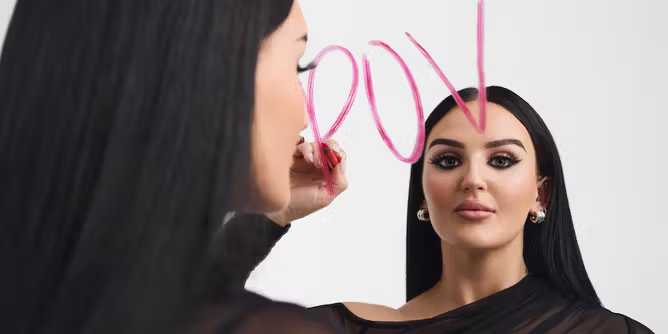This week, a look at the big business of matching holiday pajamas. It’s a trend that’s decades old, but still growing, drawing in brands from outside the sleepwear industry.
Skims’s latest holiday campaign plays on a familiar trope: a Christmas morning and a smiling family all wearing matching pajamas. In this case, the smiling family is South African model and influencer Nara Smith and her children, and the matching pajamas in festive prints are from Skims’s holiday shop collection.
Skims, which is more commonly known for its sleek loungewear and shapewear, is one of many brands capitalizing on the matching holiday pajamas market. Others include both traditional brands like Old Navy, as well as unexpected companies like Wrangler and the grocery store chain Aldi.
Holiday pajamas, particularly in the form of matching sets, are big business. Last year, total holiday pajama sales reached nearly $5 billion, with market research firm Market Intelo projecting the market to reach nearly $8 billion by 2033. Matching sets are popular for Christmas morning Instagram posts, and since kids grow out of them, parents often buy a new set every year.
Social media is helping to fuel the trend. TikTok videos tagged “matching Christmas pajamas” reached nearly half a billion views in 2024, and Pinterest-tracked searches for similar terms increased by over 130% last year.
“The holiday season is an ideal time for promoting our sleep and lounge categories, as they make excellent gifts,” Ellery Underwood, senior account management coordinator for licensing at Kontoor Brands, which owns Wrangler, said in an emailed statement. “We view this period as an opportunity to introduce new wear occasions for our brand and enhance customer loyalty.”
Aimée Lapic, CEO of the sleepwear brand Hanna Andersson, said her 40-year-old company was one of the original holiday matching pajama brands. (While matching sets had existed since the 1950s, many credit Hanna Andersson with popularizing them in the 1990s.) To this day, the category remains an important part of the brand’s business, and each year, the team finds new ways to package, market and deliver its matching holiday pajamas. Hanna Andersson has steadily added new patterns, now with over 55, as well as matching options for family members beyond parents and children, including babies, pets and grandparents.
Hanna Andersson’s latest innovation in the holiday pajama category is an online tool called Family Match, released this month, designed to help build family pajama sets. On the brand’s e-commerce site, customers are guided through the process of selecting a pattern, choosing the members of their family, and choosing fits and sizes for each. The idea is to smooth out the process of purchasing a full set of pajamas.
Lapic told Glossy that customers using the tool typically have a higher conversion rate and a higher average order value than those who shop for pieces individually. It also helps build loyalty. Using the Family Match tool, an order of pajamas for two adults, two children and a dog averages around $150, but the process provides opportunities for add-ons like matching socks, sweaters and and a pet bandana that could push the order up another $100. Hanna Andersson currently has around 999,300 loyalty members, and is likely to break 1 million in the next few weeks, according to the company.
PatPat, a California-based sleep and childrenswear brand, has made matching pajama sets a major category within its product offerings. Like Hanna Andersson, PatPat has been expanding the types of prints and the age categories of its products.
“The holiday season is absolutely pivotal for us,” said Ranu Coleman, PatPat’s head of marketing. “Matching sleepwear has evolved from being a nice-to-have into a core moment of connection for families. We have styles not just for adults and kids, but also grandparents and even the family dog — because making memories starts with the full household showing up together.”
PatPat has over 21 million customers and sells its clothes in over 140 countries. Every holiday season, it releases over 100 new prints and designs.
PatPat has a similar matching-pajama-set-building tool. A set for two adults, two children and a baby is under $100, but, like Hanna Andersson, the tool has lots of add-on options like Christmas sweaters and gift bags.
Part of what makes the product so appealing is the ability to snap family photos in matching pajamas to share on platforms like Instagram, as evidenced by the glut of celebrity posts with their families in matching sets every year. This provides brands with a wealth of UGC to work with.
“We market primarily on digital, and we have lots of brand ambassadors who highlight our pajamas,” Lapic said. “We have a holiday YouTube campaign pairing our pajamas with cozy holiday movies. And then we started doing direct mailers with photos of families wearing our pajamas, and the back of the mailer is the prints from our pajamas that can also be used as wrapping paper.”
Coleman said, for PatPat, TikTok is the No. 1 source of site traffic.
Many of its influencer partners are micro-influencers with fewer than 5,000 followers. PatPat spends about 10% of its marketing budget on influencers, which account for the same percentage of revenue.
“We lean into real family moments, UGC and micro-influencers who live the holiday vibe — not just polished campaigns alone,” she said. “Our data shows 40% of parents say social media significantly influences their children’s clothing preferences.”
Stat of the week
Nearly half of all Americans have encountered an AI-related scam during the holiday shopping season. That’s according to data from the cybersecurity company McAfee. Those scams range from fake products using AI-generated imagery to AI-powered phishing email scams, and even AI-voice-cloning identity theft scams. Thankfully, far fewer of the people who have encountered the scams have fallen for them. McAfee says one in five Americans has been scammed this holiday season, so far.
News to know
- It didn’t take long for Balmain to name a successor after Olivier Rousteing announced his departure as creative director for the brand last week. Antonin Tron, the founder of Atlein and an LVMH Prize finalist, will take on the role, with his first collection debuting in March of 2026.
- Skims secured an additional $225 million in funding, bringing its valuation to $5 billion. The company is said to be on track to pass $1 billion in net sales this year.
- As part of LVMH’s ongoing effort to boost the prestige of its watch business, the watch division of the company acquired a minority stake in La Joux-Perret, a Swiss manufacturer of high-precision watch components. La Joux-Perret is expected to integrate more deeply with the production of LVMH’s watch brands like Zenith and Tag Heuer.
Glossy’s fashion coverage
Inside fashion’s current love affair with rock ‘n’ roll
Lands’ End leans into IRL pop-ups to attract a new generation
Editor’s note: Ellery Underwood’s comment was added after this story was published.




